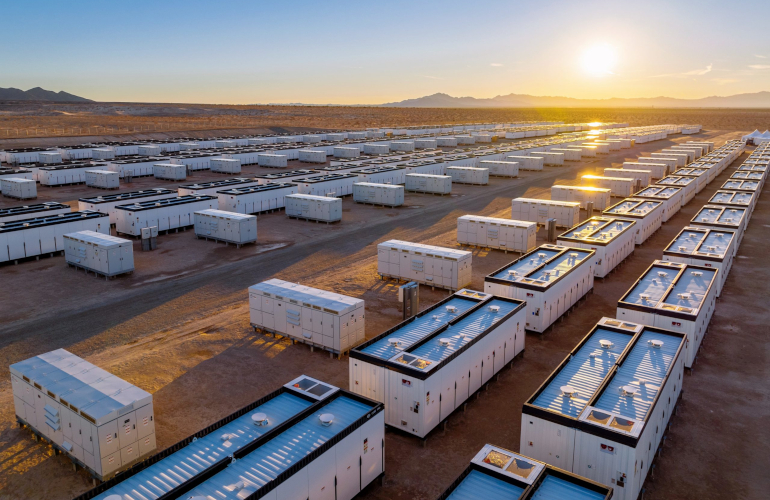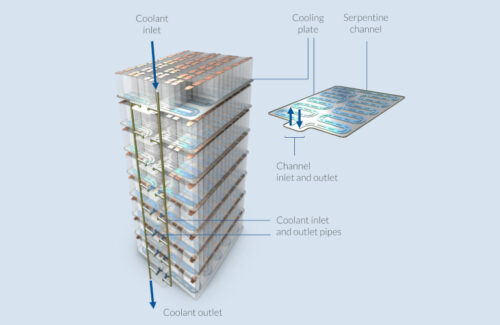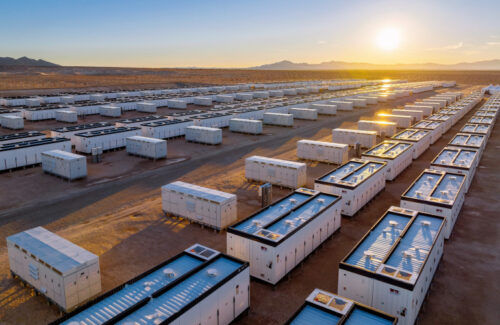As the industry gets more comfortable with how lithium batteries interact in enclosed spaces, large-scale energy storage system engineers are standardizing designs and packing more batteries into containers. For every new 5-MWh lithium-iron phosphate (LFP) energy storage container on the market, one thing is certain: a liquid cooling system will be used for temperature control. BESS manufacturers are forgoing bulky, noisy and energy-sucking HVAC systems for more dependable coolant-based options.
An illustration of a liquid-cooling system by COMSOL, a provider of simulation software for product design.
Liquid cooling as a concept is probably most recognized in vehicles with combustible engines. A car’s engine burns fuel to create energy. Some of that energy propels the car forward, and the rest is converted into heat. The engine must be kept cool, so coolant/antifreeze passes through pumps and hoses and works with the radiator to bring temperatures down. Liquid cooling systems in BESS work much in the same way — coolant cycles around battery packs to manage heat.
Liquid-cooling systems are carefully integrated into BESS containers to efficiently manage the heat, said Zhehan Yi, utility and ESS director at CPS America. The liquid-cooling system in the CPS Power Block 5-MWh container uses a multi-level system control.
“It utilizes cooling pipes and pumps that circulate the coolant across every battery module to evenly control the temperature,” he said. “There is a cooling unit in the electric compartment that exchanges the heat and cools down the coolant for circulation.”
Air-cooling is still a common thermal management solution for BESS. It uses air to dissipate heat, usually with fans, heat sinks, air conditioning systems and other HVAC components. There’s nothing wrong with air-cooling, but liquid-cooling has more consistent benefits, Yi said.
“Liquid-cooling has a higher cooling capacity and can manage the temperature more evenly. It is less affected by external temperature,” he said. “It also reduces the noise of operation compared to air-cooling.”
Liquid coolant is better at managing temperatures because the cooling lines are closer in proximity to each battery module. Air from fans can only reach so many modules, and the temperature of that air is dependent on outside conditions. Not relying on fans means sites won’t have a constant hum of operation — a welcome auditory benefit for those working and living nearby.
Fewer HVAC components also decrease auxiliary electricity consumption. Although BESS store energy for larger grid and site needs, they do need electricity for maintenance. Contained liquid-cooling systems use less electricity than HVAC, making BESS more efficient.
As for maintenance, BESS liquid-cooling systems need regular checkups just like a car’s system. Coolant levels should be checked along with the wear-and-tear of moving parts like pumps. Sensors in the system will warn operators when a part or process is failing, Yi said.
Perhaps the biggest benefit to using liquid-cooling for temperature control in BESS is allowing for more storage capacity in a smaller space. Removing most of an HVAC system and better managing individual module temperature means more battery racks can be positioned in the containers. Liquid-cooling is better at preventing thermal runaway escalation — a huge worry for system owners.
Many popular BESS brands have introduced 5-MWh models in the last few years, thanks to liquid-cooling. Hithium has graduated to the next level: a 6.25-MWh container in the same 20-ft footprint. This latest addition to the HiTHIUM ∞Block line is not yet available to the North American market (hopefully arriving in Q2 2025), but it is in line for UL 9540A testing, which determines how systems work in thermal runaway scenarios. The company’s 5-MWh models successfully completed the testing to receive certification, so the expectation is the same for the larger version.
How big can BESS go? Lithium cell capacity R&D is a forever endeavor, and their final containerized home will likely use liquid-cooling to stay comfortable — until the next big idea in temperature control.



